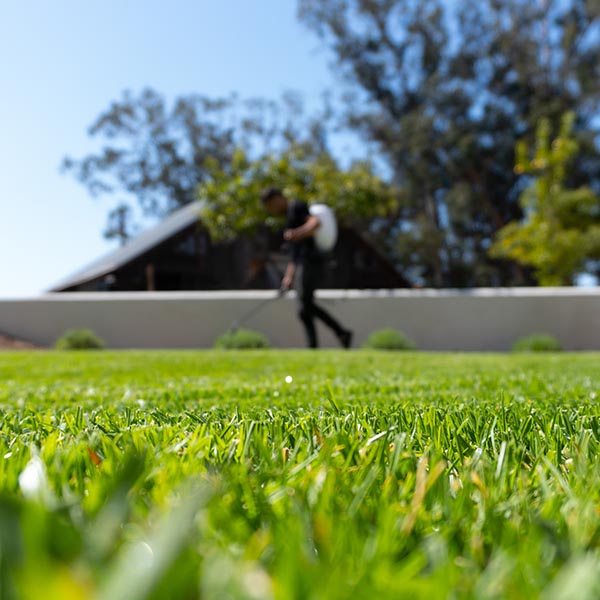Tips for Sod Installation and Maintenance
Preparing the Ground for Sod
Assess Your Yard
Identify sun, shade, and soil conditions to choose the right type of sod.
Measure the area to determine how much sod you’ll need. Add 5–10% extra for irregular areas or mistakes.
Order fresh sod from a reputable supplier, cut within 24 hours of delivery
Plan to install on the same day the sod arrives!
Prepare the Soil
Test the Soil:
Use a soil test kit to check pH, nutrient levels, and texture.
Ideal pH for most grasses is 6.0–7.5. Amend soil as needed with lime (to raise pH) or sulfur (to lower pH).
Remove Old Grass and Weeds:
Clear existing vegetation with a sod cutter or herbicide (if time permits).
Remove rocks, roots, and debris.
Till the Soil:
Loosen soil to 4–6 inches deep for better root penetration.
Grade and Level:
Ensure the area slopes slightly away from structures for proper drainage.
Use a rake or landscaping tool to level the surface.
Add Soil Amendments
Spread a layer of compost or fertilizer to enrich the soil.
Smooth and firm the soil with a lawn roller, but avoid compacting it too much.
Proper Installation Techniques
Now for the fun part! Follow the next steps carefully and you’ll be enjoying a lush, green yard in no time. This part is very satisfying and rewarding.
A few tips before you get started to keep in mind:
Work in smaller sections to avoid the sod drying out before installation.
Install sod in cooler parts of the day, such as early morning or evening, to minimize stress.
Ensure the soil underneath is moist before laying sod.
Tools You’ll Need
Lawn roller
Sod cutter or knife
Rake and shovel
Wheelbarrow
Hose and sprinkler
Fertilizer spreader
Start off on the right foot. Or the left if you prefer ;-P
Begin laying sod along the longest straight edge (e.g., driveway or fence).
Lay strips tightly together but avoid overlapping edges.
Stagger Seams
Arrange sod pieces in a brick-like pattern to avoid long, continuous seams.
Butt edges tightly, but don’t stretch the sod.
Cut and Fit
Use a sharp knife or sod cutter to trim pieces for edges and irregular areas.
Avoid small, thin pieces that may dry out quickly.
Roll the Sod
After installation, use a lawn roller to press sod firmly into the soil.
This improves root-to-soil contact and eliminates air pockets.
Maintenance Tips for Different Sod Types
The next several weeks are a crucial time for your sod, so make sure to not plan an extended absence from your sod location for at least a month following the installation date. You’ll want to do a process of properly mowing, fertilizing, weed control, and traffic control on your brand new lawn.
Mowing
Wait until the sod is well-rooted (about 2–3 weeks) before mowing.
Set the mower to the highest setting for the first cut, removing no more than ⅓ of the grass height.
Fertilizing
Apply a sod starter fertilizer immediately after installation.
Follow up with additional fertilization 4–6 weeks later based on grass type.
Traffic Restriction
Avoid heavy foot traffic or placing heavy objects on the sod for at least 2–3 weeks, even for the tough breeds of grass.
Weed Control
Avoid using herbicides until the sod is fully established (about 6–8 weeks). Though it’s unlikely you’ll see a lot of weeds, you’ll want to quickly (and gently) pull out any invaders the moment you see them for the first several weeks, then move to herbicides to take care of weeds if you want to avoid pulling them by hand.
Common Mistakes to Avoid When Choosing and Installing Sod
Ignoring Climate Suitability
The most important thing in this whole process is choosing the right sod for your climate. If you choose poorly, at best you’ll have to do a lot more maintenance on your sod than should be, such as extra watering, fertilizing, extra pest control, etc.
On the worst side of things, you will deal with mold, pests, wilting, browning, and likely a complete failure of your sod taking to its new environment, resulting in a brown, dead, weed-filled lawn.
Overlooking Soil Preparation
Many people assume that the soil that the sod ships to them with is enough to supply the sod with everything it needs. They are looking for a big disappointment. Without properly preparing the soil, you’ll have poor root establishment, drainage problems, nutrient deficiencies, weed invasions, uneven layers, increased maintenance, which all adds up to a massive waste of time and money. Don’t skip the foundation, it’s as detrimental to your sod as not having a foundation for your house.
Incorrect Watering Practices
Many people think you can just water every day and be done with it, or others think once the sod is installed they can just leave it to the man upstairs to do the watering.
Here are some ways you can go wrong and some tips on how to do it right:
Overwatering
Root Rot:
Excess water saturates the soil, depriving roots of oxygen and causing them to rot.
Shallow Root Growth:
Constantly wet soil discourages roots from growing deep, making the grass more vulnerable to drought and stress.
Increased Disease Risk:
Overwatering promotes fungal diseases like brown patch, dollar spot, and pythium blight.
Weed Growth:
Weeds like crabgrass and sedge thrive in overwatered conditions.
Nutrient Leaching:
Excess water can wash away nutrients, leaving grass nutrient-deficient and weak.
Standing Water:
Poor drainage or overwatering can lead to puddles, which attract pests and cause uneven growth.
Underwatering
Grass Dormancy:
Cool-season grasses may go dormant, turning brown and stopping growth, while warm-season grasses may die if not watered adequately.
Dry, Brittle Grass:
Insufficient water causes the blades to turn yellow or brown and become brittle.
Compromised Root System:
Without enough water, roots remain shallow and can’t access deeper soil moisture, increasing vulnerability to heat and drought.
Weed Invasion:
Dry, stressed lawns are more likely to be overtaken by weeds.
Uneven Growth:
Inconsistent watering can result in patchy, uneven growth.
Watering at the Wrong Time
Midday Watering:
Watering during the hottest part of the day causes rapid evaporation, wasting water and leaving grass thirsty.
Evening Watering:
Watering late in the day keeps the grass wet overnight, promoting fungal growth and diseases.
Improper Watering Techniques
Using Too Much Pressure:
High-pressure watering can displace soil, expose roots, and compact the soil.
Uneven Distribution:
Uneven watering creates dry spots and overwatered areas, leading to inconsistent lawn health.
Watering Too Quickly:
Rapid watering can result in runoff, wasting water and preventing deep soil penetration.
Best Practices for Proper Watering
Water Deeply and Infrequently:
Aim for 1–1.5 inches of water per week, applied in fewer sessions to encourage deep roots.
Water Early Morning:
Water between 6–10 AM to minimize evaporation and allow grass to dry before night.
Adjust for Soil Type:
Sandy soils need shorter, more frequent watering, while clay soils require slower, less frequent watering to prevent runoff.
Monitor Moisture Levels:
Check soil moisture 6 inches deep to ensure water penetrates properly.
Use Efficient Systems:
Install sprinklers, soaker hoses, or drip systems to ensure even distribution and minimize water waste.
Related Articles
The Hidden Dangers of Laying Sod Over Existing Grass
Sod installation offers homeowners an immediate solution to achieving a lush, green lawn. By...
Optimal Seasons for Laying Sod: Spring vs Fall
Temperature plays a critical role in how well sod establishes itself. Cool-season grasses, such as...
The Ultimate Guide to Watering Sod: Optimal Amounts and Schedule for a Lush Lawn
Sod is pre-grown grass that is cultivated and harvested with a layer of soil held together by...
The Pros and Cons of Sod Installation vs. Seeding Your Lawn
Hello! Let’s talk grass. Grass is everywhere.MOST places it’s growing wild. Fields, farms,...


